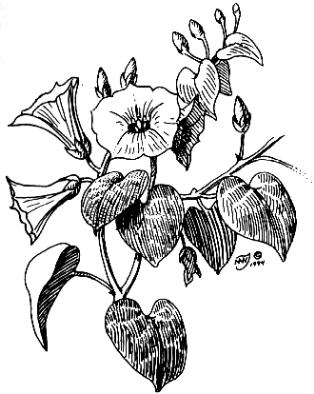- Rivea corymbosa
Taxobox
name = "Rivea corymbosa"

image_width = 250px
image_caption = "Rivea corymbosa" flowers
regnum =Plant ae
subregnum =Tracheobionta
divisio = Magnoliophyta
classis =Magnoliopsida
ordo =Solanales
familia =Convolvulaceae
genus = "Rivea "
species = "R. corymbosa"
binomial = "Rivea corymbosa"
binomial_authority = (L.) Hallier f.
synonyms = "Convolvulus corymbosus" L. "Turbina corymbosa" (L.) Raf. "Ipomoea corymbosa" (L.) Roth "Ipomoea burmannii" Choisy"Rivea corymbosa" (common synonym: "Turbina corymbosa"), is a species of
morning glory , native throughoutLatin America fromMexico in the North toPeru in the South and widely naturalised elsewhere. It is a perennial climbingvine with white flowers, often planted as anornamental plant . This plant also occurs inCuba , where it usually blooms from early December to February. Its flowers secrete copious amount of nectar, and thehoney the bees make from it is very clear and aromatic. It is considered one of the main honey plants from the island.Known to natives of
Mexico as Ololiúqui (also spelled ololiuhqui or ololiuqui), its seeds, while little known outside ofMexico , were perhaps the most common hallucinogenic drug used by the natives.In
1941 ,Richard Evans Schultes first identified ololiuhqui as "Rivea corymbosa" and the chemical composition was first described onAugust 18 ,1960 , in a paper by Dr. Albert Hofmann. The seeds containergine (LSA), anergoline alkaloid similar in structure toLSD .The
Nahuatl word "ololiuhqui" means "round thing", and refers to the small, brown, oval seeds of the morning glory, not the plant itself, which is called "coaxihuitl", "snake-plant", in Nahuatl, and "hiedra" or "bejuco" in theSpanish language . The seeds, in Spanish, are sometimes called "semilla de la Virgen" (seeds of the Virgin Mary).The seeds are also used by Native curers in order to gain knowledge in curing practices and ritual, as well as the causes for the illness.
This species is an
invasive species to theUnited States . As well as toAustralia , where it has become more naturalized.External links
* [http://plants.usda.gov/java/profile?symbol=TUCO PLANTS database entry]
* [http://www.erowid.org/plants/morning_glory/morning_glory.shtml Erowid Morning Glory vault]
Wikimedia Foundation. 2010.
